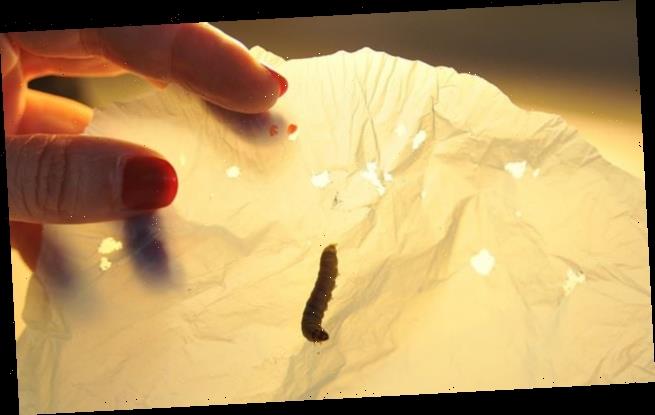Very hungry caterpillar that chomps its way through PLASTIC could help speed up the breakdown of carrier bags and other litter
- Wax worms are a pest which live on a diet of beeswax when found in the wild
- The caterpillar and its gut bacteria are also able to survive by eating plastic
- Specifically, the pest is adept at breaking down low-density polyethylene (LDPE)
- Sixty wax worms could consume around 4.5 square inches of plastic a week
The unique digestive system of a small caterpillar that is powered by tiny bacteria could hold the key to ridding the world of plastic waste.
Wax worms are a naturally occurring pest which survive in the wild by invading beehives and eating the beeswax inside.
Researchers discovered that this particular diet has cultivated an array of bacteria which can break down the hardy honeycomb — and it also digests plastic.
Specifically, the bee pest is adept at breaking down low-density polyethylene (LDPE) which is widely used, most notably in carrier bags.
Scroll down for video
Wax worms are a naturally occurring pest which survive in the wild by invading beehives and eating the beeswax inside. The bee pest is also adept at breaking down low-density polyethylene (LDPE) which is widely used, most notably in carrier bags
WHAT IS LDPE?
Low-density polyethylene is a commonly used form of plastic.
It is commonly known by its acronym, LDPE.
It is very versatile as it is semi-rigid, translucent tough and weatherproof.
It can be produced cheaply and easily and is resistant to chemical damage.
These properties mean it is widely used by humans.
It is used to produce bottles, toys, carrier bags, chemical tank linings, packaging and pipes.
Experiments by researchers at the Brandon University in Canada found around 60 of the moth larvae could consume around 4.5 square inches of plastic every week.
The worms themselves can survive on a diet of only plastic for several weeks, the study confirmed.
However, some specific species of bacteria found in the invertebrate’s gut could live on a diet consisting solely of plastic for more than a year.
However, the rate of plastic consumption is highest when the bacteria works in tandem with the caterpillar as opposed to outside its host animal.
Christophe LeMoine, the lead researcher of the study, told The Times: ‘We think it is quite phenomenal that these insects are able to survive for weeks on a diet made entirely of plastic.
‘There appears to be a synergy between the waxworm and its gut bacteria that accelerates plastic biodegradation.
‘A better understanding of how this works may guide future efforts to design the ‘perfect’ plastic biodegradation system.’
One potential issue faced by scientists hoping to use worms to combat litter and plastic waste is the byproduct the worms create.
As they chomp down on plastic, the wax worms produce a metabolic waste product called ethylene glycol, which is toxic.
The findings were published in the journal Proceedings of the Royal Society B: Biological Sciences.
Source: Read Full Article

